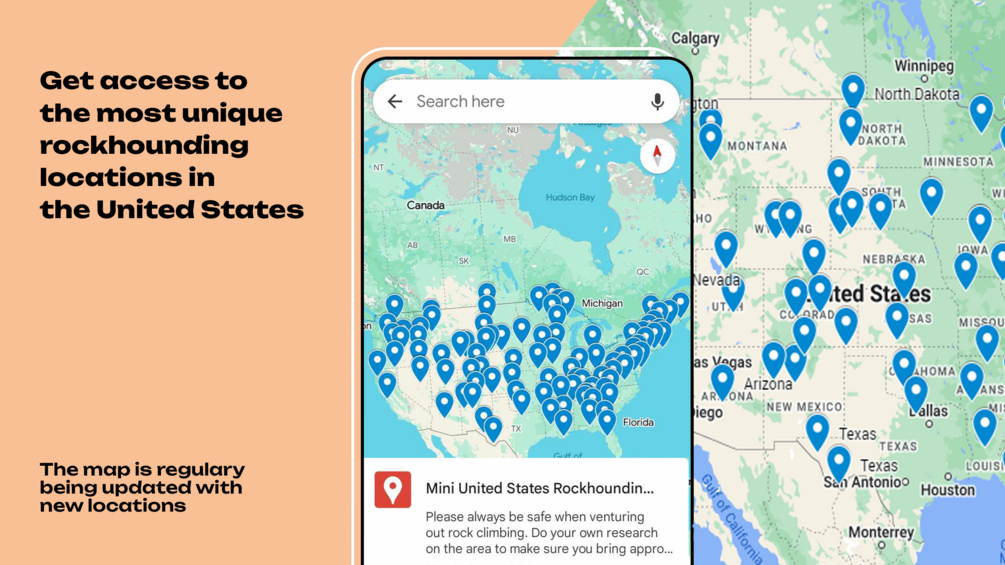New Hampshire’s rugged beauty isn’t just skin deep—beneath its forested hills and mountain streams lie hidden geological treasures.
If you’re a rockhound, the Granite State offers a treasure trove of mineral finds, from quartz to beryl, and you’re in the right place to discover where to dig in.
Whether you’re a seasoned collector or just starting out, New Hampshire’s diverse geology provides a variety of locales that are as rich in scenery as they are in specimens. You’ll find that with a little patience and the right tools, you can unearth your own piece of New Hampshire’s natural history.
So grab your gear, and let’s explore the prime rockhounding spots that await you in this northeastern gem.
In New Hampshire, rockhounding enthusiasts can explore a range of sites rich in minerals like quartz, beryl, garnet, and smoky quartz. Key locations include the White Mountains for quartz and mica, Moat Mountain for smoky quartz, Palermo Mine for lithium-rich minerals, and Alstead for beryl and garnet.
Get our FREE United States Rockhounding Map HERE

New Hampshire Rockhounding Locations
Embarking on a rockhounding adventure in New Hampshire brings you closer to nature and can be a thrilling excursion for collectors of all levels. The White Mountains region is notorious for its abundance of minerals. You’ll find quartz, mica, and a variety of feldspar species just waiting to be discovered. Perhaps you’re after the state gem, smoky quartz. If that’s the case, head to the Moat Mountain Mineral Site, where you’re permitted to dig for your own specimens.
Not far from there, the Palermo Mine offers opportunities to find rarities like lithium-rich minerals. Though now closed for active mining, field trips organized by local mineral clubs often grant you access. Remember, getting permission first is essential when visiting any rockhounding site.
In the southwestern part of New Hampshire, the area around Alstead is well-known for its abundance of granite pegmatites, rich in both beryl and garnet. This region tends to be less frequented, so your chances of a unique find are high. Keeping in mind responsible practices, you can explore old mines and quarries that pepper the landscape, vestiges of New Hampshire’s robust mining history.
For the coastal enthusiasts, Rye Beach can surprise you with its offerings of quartz crystals and sea-worn stones. After a storm, the chances of finding something exciting along the shoreline increase significantly.
| Location | Notable Finds |
|---|---|
| White Mountains | Quartz, Mica, Feldspar |
| Moat Mountain | Smoky Quartz |
| Palermo Mine | Lithium-rich Minerals |
| Alstead | Beryl, Garnet |
| Rye Beach | Sea-worn Stones, Quartz |
Always check local guidelines and restrictions as some locales may require a permit for rockhounding. This aspect of the hobby is as important as the thrill of finding a hidden treasure beneath the earth. Gear up, respect the natural habitats, and you’re all set to delve into the geological wonders that the Granite State has to offer.
What Gemstones are Found in New Hampshire?

In New Hampshire’s treasure trove of minerals, gemstone enthusiasts will find a variety of enticing specimens. Whether you’re an aspiring geologist or a seasoned collector, knowing what gems you might come across can turn your rockhounding trip into a highly rewarding endeavor.
Beryl, in hues of green, blue, and yellow, is a star attraction for rockhounds. The local variety of beryl, aquamarine, can be found with a bit of effort and is a true prize for any collection. Additionally, New Hampshire is recognized for its garnets, typically ranging from deep red to vibrant green shades. Although small, their clarity and color can be quite remarkable.
Amethyst is another gemstone that calls the Granite State home. High-quality amethyst can be found throughout the state, especially in the areas surrounding granite pegmatites. Your patience might be rewarded with purple crystals that have a clarity making them ideal for jewelry.
Smoky quartz, New Hampshire’s official state gem, is not only prevalent but also can be found in impressive sizes and quality. Keen rockhounds have uncovered smoky quartz crystals that are museum-worthy — a testament to the rich mineral deposits scattered across the state.
As you search for these hidden gems, keep in mind the need for a gentle hand and the right tools. Rockhounding is as much about the experience as it is about the discoveries. Take your time to explore the ridges and valleys that hide these precious stones. Remember, some of the best spots to find these jewels are the lesser-trodden paths where nature has concealed her treasures just below the surface.
| Gemstone | Color Variants | Common Locations in NH |
|---|---|---|
| Beryl | Green, Blue, Yellow | Granite Pegmatites |
| Garnet | Red, Green | White Mountains Region |
| Amethyst | Purple | Areas Around Pegmatites |
| Smoky Quartz | Brown to Black | Moat Mountain, Others |
What Sedimentary Rocks You Can Find in New Hampshire?

While New Hampshire is well-known for its wealth of igneous and metamorphic rocks, sedimentary rocks are more elusive but still present, offering a different kind of thrill for rockhounds. In the layers of New Hampshire’s geology, you’ll discover sedimentary gems that hold the secrets of the region’s ancient environments.
One of the key locations where you can find sedimentary rocks is in the Connecticut River Valley. Here, layers of sediment deposited over millions of years have solidified into rock. These deposits offer a glimpse into the distant past where once a tropical environment thrived. As you explore, you could uncover:
- Sandstone
- Siltstone
- Shale
Each of these rocks provides vital clues to the geological and environmental history of New Hampshire. Sandstone, often recognizable by its granular texture, indicates the presence of past sand beaches and deserts. Siltstone, with its fine-grained structure, suggests quieter waterways or floodplains. Shale, typically found in stratified layers, can signify an even deeper history of ancient sea beds or lakes.
In certain areas, particularly near the base of the White Mountains, the sedimentary layers have undergone less intense folding and faulting, thus preserving the rock’s original bedding features. This offers rockhounds an educational experience, as you can see firsthand how sedimentary strata are layered and can interpret the formation processes.
Remember to obtain permission if you’re on private land, and be aware that certain sites may fall under protection for their geological significance. Your ethical rockhounding practices help preserve these sites for future generations of enthusiasts.
Stepping into these areas, you’re not just hunting for rocks; you’re embarking on a treasure hunt through time. Keep your eyes peeled for fossils that occasionally make an appearance within these sedimentary stones, adding an extra layer of excitement to your adventure.
What Metamorphic Rocks are found in New Hampshire?
Rockhounding in New Hampshire unveils a treasure trove of metamorphic rocks, each telling a unique story of the state’s dynamic geologic past. As you explore, you’ll find that schist and gneiss are among the most common metamorphic rocks. These rocks transformed under immense heat and pressure, creating beautifully foliated textures that make them highly sought after.
The White Mountains region is particularly renowned for its diverse metamorphic minerals. Picture yourself navigating the rugged terrain where you might stumble upon impressive specimens of garnet-bearing mica schist. The striking red garnets set within silvery layers of schist can be a dazzling find on your rockhounding journey.
In addition to garnets, New Hampshire’s metamorphic rocks are known for their deposits of beryl and tourmaline. The geological conditions that contribute to the formation of these minerals can lead to displays of color and crystal structure that are a marvel to behold. Let’s break down some key locations and the metamorphic wonders you can find:
- Coos County: Known for its luscious green beryl crystals embedded in mica schist.
- Grafton County: A hotspot for collecting tourmaline, with the possibility of unearthing pink, green, or black varieties.
Safety and Preservation Tips
While your search for metamorphic rocks is sure to be an adventure, always remember the importance of respecting the land and staying safe. Make sure you’re equipped with the right tools and knowledge of the terrain before setting out. Proper safety gear including helmets, gloves, and reliable footwear, is a must to navigate the sometimes steep and loose terrain where these rocks are found.
It’s essential to maintain the integrity of natural sites. This means taking nothing but pictures and leaving nothing but footprints. Moreover, ensure you’re fully aware of the collecting regulations as they differ across various regions and land types in New Hampshire.
Remember, each rock you find is more than just a simple stone; it’s a piece of earth’s history. With each discovery, you’re uncovering parts of the geological narrative that has shaped New Hampshire over millions of years.
What Igneous Rocks can You Find in New Hampshire?
When you’re combing the New Hampshire landscape, you’ll be thrilled to find an abundance of igneous rocks. This region boasts an incredible variety of ancient volcanic and plutonic formations. Among the most sought-after igneous rocks you’ll encounter is granite, New Hampshire’s state rock. Known for its durability and beauty, granite is prolific throughout the state’s quarries and mountainsides.
Delve into the depths of New Hampshire’s rockhounding locales, and you might stumble upon pegmatite, a coarse-grained igneous rock containing large, well-formed crystals. Pegmatite is particularly known for housing a treasure trove of minerals, including semi-precious gems such as:
- Aquamarine
- Smoky quartz
- Topaz
Another exciting find is rhyolite, a volcanic rock that’s similar in composition to granite but with a finer texture. Often found in shades of grey, green, or pink, rhyolite’s presence tells of the state’s explosive volcanic history.
Don’t miss the chance to search for basalt, commonly found in the state’s ancient lava flows. Basalt is easily identified by its dark color and fine-grained texture; it’s indicative of the rapid cooling that occurs as lava meets the surface.
While traversing the state’s rockhounding spots, be sure to check out the Zealand Notch area in the White Mountains. Here, you’ll not only encounter stunning igneous formations but also enjoy breathtaking views that’ll make your rockhounding journey unforgettable.
Panning for Gold in New Hampshire
If you’re seeking a different kind of treasure in New Hampshire, panning for gold might just be your next great adventure. The state isn’t famous for its gold deposits like California or Alaska, but that doesn’t mean there’s no gold to be found. In fact, hobbyists and enthusiasts regularly enjoy the thrill of discovering flakes and nuggets in New Hampshire’s rivers and streams.
Start your quest in the Northern part of the state, where placer gold has historically been found in the Swift and Ammonoosuc Rivers. Here’s what you should keep in mind:
- Obtain proper permission or permits if required
- Use environmentally friendly panning methods
- Respect private property and state laws
You’ll typically find finer gold particles in New Hampshire, rather than large nuggets. Nevertheless, the excitement of unearthing your own precious find is unbeatable. The Crawford Notch area and Coos County are popular spots among gold panners, with a history of small but significant finds.
When panning, you’ll want a panner’s kit and perhaps a sluice box to increase your chances of success. Take your time to swirl the water and sediment in your pan; patience is often rewarded in gold panning. Keep an eye out for black sand — it’s a good indicator that gold may be nearby, as both are often found together in nature.
Understanding New Hampshire’s geology can also give you an edge. The state’s bedrock is laced with quartz veins where gold can be trapped. These areas, often near old mines and rocky streams, can be prime locations for gold panning.
Remember, the best gold panning spots are often found off the beaten path, so don’t be afraid to explore. However, always stay aware of your surroundings and maintain a high level of safety. Prospecting can be rewarding but it’s important to preserve the pristine nature of New Hampshire’s landscapes for future generations to enjoy their own adventures.
Rocks and Minerals Found in New Hampshire
As you traverse the diverse terrain of New Hampshire, you’ll discover an array of rocks and minerals that are both beautiful and geologically significant. The state’s rich geological tapestry includes metamorphic, sedimentary, and igneous rocks, making it a haven for rockhounds.
Metamorphic rocks are prevalent, with schist and gneiss found throughout the region. These rocks often contain garnets and staurolite, which you can identify by their distinctive red and brown hues, respectively.
In areas where sedimentary rocks emerge, like in the Connecticut River Valley, you’ll encounter deposits of limestone and shale. These deposits aren’t just geological treasures but also hold fossils that whisper tales of ancient marine environments. Keep an eye out for impressions of ancient plants and sea creatures embedded in these stones.
New Hampshire’s igneous rocks, as previously mentioned, present a variety of minerals. Unearthing crystals of beryl or tourmaline within granite pegmatites can be particularly thrilling. The state’s famed pegmatite mines offer chances to find large, well-formed crystals.
| Mineral Type | Notable Locations |
|---|---|
| Beryl | Grafton, Groton |
| Tourmaline | Haverhill, Alstead |
| Smoky Quartz | Conway |
| Topaz | Cheshire County |
While exploring, don’t forget that New Hampshire is also home to less common minerals such as amblygonite, eosphorite, and babingtonite, which are prizes for any serious collector.
Remember to pack your tools – a good hammer, chisel, and eye protection are essential. And while you’re immersing yourself in the rockhound experience, make sure to obtain permission for any private land you might want to explore and adhere to the regulations set forth by state parks and public lands. The thrill of discovery awaits as you navigate the rich mineral localities of the Granite State.
Where Can I Find Fossils in New Hampshire?
New Hampshire may not be the first state that comes to mind when you think about fossil hunting, but it’s got a few hidden gems that are well worth exploring. Fossiliferous locations in the Granite State are fairly spread out, so you’ll need a bit of a guide to find where these ancient records are buried.
One of the most popular spots is the Littleton Formation, located in the northwestern part of the state. Here, you can uncover fossils that are a testament to an ancient deep sea environment. Think trilobites, brachiopods, and other marine creatures from the Paleozoic era. Be aware, though, the region’s prevalent metamorphic activity may have altered some of the fossils, making them harder to identify.
Next, take a trip to the Connecticut River Valley, especially near Hanover and Lebanon, where you can find impressively preserved fossils from the Devonian period. The layers of sedimentary rock here are ripe for the patient rockhound.
For those interested in plant fossils, a visit to the coal-bearing formations found in the southwestern region of New Hampshire, mainly around Keene, can be especially fruitful. Keep your eyes peeled for imprints of ancient flora that have been locked away in shale and siltstone for ages.
Before you set out on your journey, remember to research each site and make sure it’s accessible to the public. Some areas may be on private property or have restrictions, so always seek permission when necessary. Also, be mindful of the legalities of fossil collecting in New Hampshire and ensure that you’re not removing specimens from protected lands.
Equipping yourself with a good fossil field guide for the Northeast can make your hunt more successful, as it’ll help you identify formations and the types of fossils you’re likely to encounter. Happy hunting as you delve into Earth’s past and uncover the fossilized wonders of New Hampshire.
New Hampshire Rockhounding Laws & Regulations
When you’re keen to start rockhounding in New Hampshire, understanding the local laws and regulations is essential. New Hampshire’s guidelines ensure that rockhounding activities are both respectful of the environment and considerate of landowners’ rights.
In general, public lands in New Hampshire allow for the collection of small amounts of rocks, minerals, and fossils without a permit. However, State Parks often have stricter rules. You’re typically barred from removing any natural materials from these protected areas. Before setting out, it’s best practice to check the specific regulations for the area you plan to visit.
On private lands, it’s imperative you seek permission from the landowner. Trespassing to collect specimens is illegal and can result in hefty fines. Many landowners are willing to allow collectors if asked directly, and provided you follow any guidelines they may set.
When it comes to federal lands, such as National Forests, rules become more stringent. While casual collecting of common invertebrate and plant fossils is allowed, vertebrate fossils are off-limits. For more substantial collecting activities that could disrupt the land, permits are required.
Mineral Collecting Permits vary based on the location and the type of minerals you’re after. The Bureau of Land Management (BLM) manages mining claims and mineral rights on federal lands. To collect minerals commercially or in large quantities, engaging with the BLM for the appropriate permits is a must.
Here are some key points to remember:
- Always check specific area regulations
- Obtain landowner permission for collecting on private property
- Familiarize yourself with state park rules to avoid infractions
- Understand federal land requirements; permits may be necessary
Keep these regulations in mind, and you’ll help preserve New Hampshire’s geological heritage for future generations of rockhounds. With due diligence, your rockhounding adventure can be both successful and lawful, blending your passion for collecting with a respect for conservation and property rights.
Rockhounding Tips for Beginners in New Hampshire
Rockhounding can be a thrilling experience for beginners, especially in a state rich with geological diversity like New Hampshire. To make your adventure as enjoyable and productive as possible, it’s vital to go prepared. Below, you’ll find some essential advice on what to bring, how to stay safe, and the legalities to bear in mind.
Gearing Up: Essential Tools for Rockhounding
To begin your rockhounding journey, it’s critical to have the right gear. Here’s a brief list of must-haves for any beginner:
- Rock Hammer: A sturdy rock hammer is your fundamental tool for chipping away at rocks and extracting specimens.
- Chisels and Picks: Different sizes can help you delicately separate layers and avoid damaging your finds.
- Safety Goggles: Eye protection is a non-negotiable. Always wear them while hammering or chiseling rock.
- Sturdy Gloves: Protect your hands from sharp edges and improve your grip.
- Field Bag: A backpack or belt bag to carry your tools and treasures safely.
- Water Bottle: Hydration is crucial, especially during the warmer months.
- Maps and GPS: Knowing your location and how to navigate to specific sites is key.
Safety Tips While Rockhounding
While rockhounding is generally a safe hobby, there are important safety tips you should always follow:
- Always let someone know where you’re going and when you expect to return.
- Check the weather forecast before you head out to avoid being caught in dangerous conditions.
- Rock faces and slopes can be unstable. Stay aware of your surroundings and avoid overhangs that could collapse.
- Wildlife encounters are possible, especially in remote areas. Know what to do if you come across any of New Hampshire’s fauna.
- First-aid kit: Carry a basic first-aid kit to handle minor injuries on the spot.
Legal Guidelines for Rockhounding Enthusiasts
Being aware of and following legal guidelines is fundamental for a hassle-free rockhounding experience. Here’s what you need to keep in mind:
- Permission is Key: Always obtain permission to collect on private land and know the regulations for public areas.
- Collecting may be restricted or prohibited in state parks, national parks, and protected areas. Check the rules for each site you plan to visit.
- Mind the Limitations: Some places may allow collecting for personal use but prohibit commercial collecting. Familiarize yourself with these distinctions.
- Respect the Land: Leave no trace of your visit and never deface rock formations or natural features. Preservation is paramount.
Conclusion: New Hampshire Rockhounding Locations
Armed with the right tools and a keen sense of adventure, you’re now ready to explore the rich geological playground of New Hampshire.
Remember, safety is paramount, so always be prepared for the unexpected and respect the environment you’re delving into. With the legal guidelines in mind, you can enjoy a guilt-free treasure hunt across the Granite State’s diverse landscapes. Whether you’re searching for quartz, beryl, or garnet, the thrill of discovery is just a stone’s throw away.
So grab your gear, embrace the rockhound’s code of ethics, and set out on a journey that promises both wonder and reward.


![OK Rockhounding Sites in [year]: Best Spots & Finds](https://observationhobbies.com/wp-content/uploads/2024/01/SOQ30nAxQQ71Hv_lw9va_-768x439.jpg)


![Tennessee Rockhounding Sites in [year]: Gems & Fossils](https://observationhobbies.com/wp-content/uploads/2024/01/EFGCim-a-H4l1G9wAyX6B-768x439.jpg)

![Texas Rockhounding Sites in [year]: What You’ll Discover & Where](https://observationhobbies.com/wp-content/uploads/2024/01/MZHIzqyqCDorVgqMLNsPb-768x439.jpg)